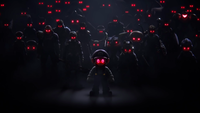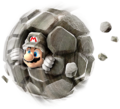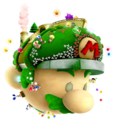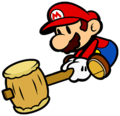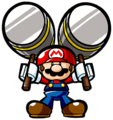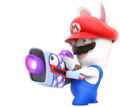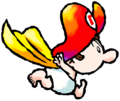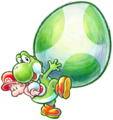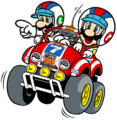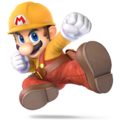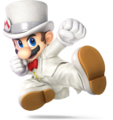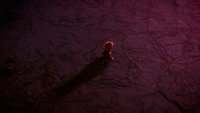Mario (SSBU)
| Mario in Super Smash Bros. Ultimate | |
|---|---|
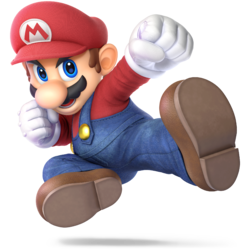 
| |
| Universe | Mario |
| Other playable appearances | in SSB in Melee in Brawl in SSB4 |
| Availability | Starter (Unlockable in World of Light) |
| Final Smash | Mario Finale |
| “ | Mario is an all-around fighter who uses his wide variety of techniques to respond to any situation. In Super Smash Bros. Ultimate, he shows up in his Wedding tux and his Builder outfit, and Cappy even makes an appearance! | ” |
| —Super Smash Blog, Super Smash Bros. Ultimate Official Site | ||
Mario (マリオ, Mario) is a playable character in Super Smash Bros. Ultimate. He was suggested to appear in the then unnamed Ultimate in its first teaser trailer at the end of the March 8th, 2018 Nintendo Direct, and officially announced in Ultimate's E3 2018 trailer on June 12th, 2018 alongside the rest of the returning roster. Mario is classified as fighter #01.
As in Smash 4, Charles Martinet's portrayal of Mario from Brawl was repurposed for Ultimate.
Changes from Super Smash Bros. 4
Comparatively to other fighters, Mario has received very few major direct changes in his transition from SSB4 to Ultimate, possibly less than any other fighter. However, changes and overhauls to pre-established mechanics from SSB4 to Ultimate have impacted Mario to a higher degree, resulting in a mix of buffs and nerfs overall.
One of the biggest detriments to Mario's toolkit was the universal nerfing of grabs; infamously known for his potentially devastating throw combos in SSB4, the increased endlag of all grabs have affected Mario more negatively compared to other fighters. Furthermore, up tilt, one of his most pivotal moves previously, has had altered hitbox placements resulting it not only a range reduction, but said range reduction also effectively removes it as a reliable follow-up from his down throw at any percents. His dash attack can also no longer serve as a reliable 2 frame punish that leads into a stage spike, due to its late hit's angle being altered to send opponents away from Mario. On top of this, because of the changes to rage, Super Jump Punch is much less effective for taking out stocks off the upper blast line below high percents.
However, changes to Ultimate's mechanics have also benefited Mario; his already strong set of aerials has been improved even further as a result of the universal changes to the landing lag of aerials. This not only makes them safer on shield, but it also allows for more reliable combos and even devastating KO setups, such as up air into forward aerial. Mario also benefits from faster walking, dashing, and air speeds, since his higher mobility allows him to string attacks together more effectively and close in on opponents' more effectively. Lastly, the added ability to dash cancel has improved Mario's ground game further given his strong set of tilts, with up tilt and down tilt serving as reliable combo starters. The reduced jumpsquat durations and decreased landing lag across the cast also give him greater combo opportunities, with his up throw in particular becoming a more effective combo starter.
Lastly, Mario has received a few direct noteworthy buffs as well. His forward tilt is much more effective as a spacing option due to its higher base knockback, lower ending lag, and the increased shieldstun for ground attacks besides smash attacks. Furthermore, Fireball and F.L.U.D.D. have slightly less ending lag, making them safer options at longer distances.
Overall, it is currently undetermined whether Mario has been truly buffed or nerfed from Smash 4, as both his buffs and nerfs impact him to a similar degree. Nevertheless, he has amassed strong results in the early metagame of Ultimate, and is currently represented by notable players such as Zenyou, Dark Wizzy, Prodigy, and Super Dan.
Aesthetics
 As with all veterans returning from Smash 4, Mario's model features a more subdued color scheme. His clothing and hair now feature simple detailing, similar to his design in Brawl.
As with all veterans returning from Smash 4, Mario's model features a more subdued color scheme. His clothing and hair now feature simple detailing, similar to his design in Brawl. Mario's standard cap has been replaced by Cappy from Super Mario Odyssey. Cappy's eyes can appear during Super Jump Punch, but he otherwise has no effect on gameplay.
Mario's standard cap has been replaced by Cappy from Super Mario Odyssey. Cappy's eyes can appear during Super Jump Punch, but he otherwise has no effect on gameplay. Mario's idle animation is altered slightly; his head is turned more towards the screen, but he still looks toward his front.
Mario's idle animation is altered slightly; his head is turned more towards the screen, but he still looks toward his front. Mario, like many other characters, has been made much more expressive in this game, to an even greater degree than its predecessor. In particular, he will sometimes smile and appear whimsical or happy in battle, in line with his canon depiction, although he still looks serious and with angry brows most of the time.
Mario, like many other characters, has been made much more expressive in this game, to an even greater degree than its predecessor. In particular, he will sometimes smile and appear whimsical or happy in battle, in line with his canon depiction, although he still looks serious and with angry brows most of the time. Many of Mario's animations have been slightly altered. His walking, helpless, skidding, and ledge-hanging animations are just a few examples.
Many of Mario's animations have been slightly altered. His walking, helpless, skidding, and ledge-hanging animations are just a few examples. Mario has a slightly different pose during air dodge, and has an angry expression on his face.
Mario has a slightly different pose during air dodge, and has an angry expression on his face. Mario's mustache now has physics-based movement.
Mario's mustache now has physics-based movement. Mario's attacks, especially ones involving fire, have been given brighter, flashier particle effects.
Mario's attacks, especially ones involving fire, have been given brighter, flashier particle effects. Mario has two new taunts: one where he turns his back to the camera and gives a thumbs-up, and another where he throws Cappy around in a circle. They replace his previous up and side taunts, respectively.
Mario has two new taunts: one where he turns his back to the camera and gives a thumbs-up, and another where he throws Cappy around in a circle. They replace his previous up and side taunts, respectively.
 Up taunt no longer massively increases Mario's hurtbox, which combined with its much faster speed and taunt canceling makes it much harder to punish.
Up taunt no longer massively increases Mario's hurtbox, which combined with its much faster speed and taunt canceling makes it much harder to punish.
 Mario performs his down taunt much faster.
Mario performs his down taunt much faster. Mario's Builder outfit from Super Mario Maker and his Wedding tuxedo from Super Mario Odyssey are present as alternate costumes. They replace his Wario-inspired costume and his Fire Mario costume, respectively.
Mario's Builder outfit from Super Mario Maker and his Wedding tuxedo from Super Mario Odyssey are present as alternate costumes. They replace his Wario-inspired costume and his Fire Mario costume, respectively. Mario's spin jump victory animation has been altered slightly; he jumps much higher, spins around only once, and has a happy expression after landing.
Mario's spin jump victory animation has been altered slightly; he jumps much higher, spins around only once, and has a happy expression after landing. Mario now smiles when applauding the winner after a match.
Mario now smiles when applauding the winner after a match. Mario's on-screen appearance is mirrored.
Mario's on-screen appearance is mirrored.
Attributes
 Like all characters, Mario's jumpsquat animation now takes 3 frames to complete (down from 5).
Like all characters, Mario's jumpsquat animation now takes 3 frames to complete (down from 5). Mario jumps slightly higher.
Mario jumps slightly higher. Mario walks slightly faster (1.1 → 1.155).
Mario walks slightly faster (1.1 → 1.155). Mario runs faster (1.6 → 1.76).
Mario runs faster (1.6 → 1.76).
 Mario's initial dash is faster (1.6 → 1.936).
Mario's initial dash is faster (1.6 → 1.936).
 Mario's air speed is faster (1.15 → 1.208).
Mario's air speed is faster (1.15 → 1.208). Mario's traction is much higher (0.045 → 0.102), allowing him to punish out of shield more easily.
Mario's traction is much higher (0.045 → 0.102), allowing him to punish out of shield more easily. Mario's gravity is slightly lower (0.08715 → 0.087).
Mario's gravity is slightly lower (0.08715 → 0.087). Forward roll grants less intangibility (frames 4-16 → 4-15).
Forward roll grants less intangibility (frames 4-16 → 4-15). Back roll has more startup with less intangibility (frames 4-16 → 5-16), and more ending lag (FAF 30 → 35).
Back roll has more startup with less intangibility (frames 4-16 → 5-16), and more ending lag (FAF 30 → 35). Spot dodge has less ending lag (FAF 27 → 26).
Spot dodge has less ending lag (FAF 27 → 26). Air dodge grants more intangibility (frames 3-27 → 3-29).
Air dodge grants more intangibility (frames 3-27 → 3-29). Air dodge has significantly more ending lag (FAF 33 → 53).
Air dodge has significantly more ending lag (FAF 33 → 53).
Ground attacks
- Neutral attack:
 Consecutive uses of the first hit of neutral attack are faster (9 → 6 frames).
Consecutive uses of the first hit of neutral attack are faster (9 → 6 frames). The first two hits transition into the subsequent hits faster (hit 1: frame 8 → 5, hit 2: frame 7 → 6).
The first two hits transition into the subsequent hits faster (hit 1: frame 8 → 5, hit 2: frame 7 → 6). The third hit comes out faster (frame 7 → 3) and goes higher, allowing it to connect better from the first two hits.
The third hit comes out faster (frame 7 → 3) and goes higher, allowing it to connect better from the first two hits.
 However, its total duration remains unchanged, giving it more ending lag.
However, its total duration remains unchanged, giving it more ending lag.
 The first two hits deal altered damage (2.5% → 2.2% (hit 1), 1.5% → 1.7% (hit 2)), resulting in the move dealing slightly less damage in total (8% → 7.9%).
The first two hits deal altered damage (2.5% → 2.2% (hit 1), 1.5% → 1.7% (hit 2)), resulting in the move dealing slightly less damage in total (8% → 7.9%).
- Forward tilt:
 Forward tilt deals more base knockback, increasing its safety on hit at low percents.
Forward tilt deals more base knockback, increasing its safety on hit at low percents. It has less ending lag (FAF 31 → 26).
It has less ending lag (FAF 31 → 26).
- Up tilt:
 Up tilt's animation has been reversed, with Mario spinning towards the screen rather than away from it.
Up tilt's animation has been reversed, with Mario spinning towards the screen rather than away from it. Up tilt has less horizontal range, and its hitboxes start from a higher position, rendering it unable to hit some characters on the ground.
Up tilt has less horizontal range, and its hitboxes start from a higher position, rendering it unable to hit some characters on the ground.
- Down tilt:
 Down tilt's animation has been reversed, with Mario spinning towards the screen rather than away from it.
Down tilt's animation has been reversed, with Mario spinning towards the screen rather than away from it.
- Dash attack:
 Dash attack travels further.
Dash attack travels further. It has an altered animation that no longer lowers Mario's hurtbox, which prevents him from sliding under certain attacks.
It has an altered animation that no longer lowers Mario's hurtbox, which prevents him from sliding under certain attacks. The late hit launches opponents away from Mario like the clean hit, rather than towards him, hindering its combo potential and preventing it from stage spiking opponents below edges.
The late hit launches opponents away from Mario like the clean hit, rather than towards him, hindering its combo potential and preventing it from stage spiking opponents below edges.
- Forward smash:
 Forward smash deals consistent damage across all angles, increasing it overall (14%/17% (forward), 14.7%/17.85% (up), 14.42%/17.51% (down) → 14.7%/17.8% (all)).
Forward smash deals consistent damage across all angles, increasing it overall (14%/17% (forward), 14.7%/17.85% (up), 14.42%/17.51% (down) → 14.7%/17.8% (all)).
- Up smash:
 Up smash's animation has been reversed, with Mario facing towards the screen rather than away from it.
Up smash's animation has been reversed, with Mario facing towards the screen rather than away from it.
- Down smash:
 Down smash's animation has been altered, resembling both the Sweep Kick move from Super Mario 64, and the break dance Mario performs on the cover of Dance Dance Revolution: Mario Mix.
Down smash's animation has been altered, resembling both the Sweep Kick move from Super Mario 64, and the break dance Mario performs on the cover of Dance Dance Revolution: Mario Mix.
Aerial attacks
 All aerials have reduced landing lag (10 frames → 6 (neutral), 26 frames → 17 (forward), 12 frames → 6 (back), 12 frames → 6 (up), 19 frames → 15 (down)).
All aerials have reduced landing lag (10 frames → 6 (neutral), 26 frames → 17 (forward), 12 frames → 6 (back), 12 frames → 6 (up), 19 frames → 15 (down)).- Forward aerial:
 The removal of teching for grounded meteor smashes improves forward aerial's combo potential onstage, compounded further by its reduced landing lag.
The removal of teching for grounded meteor smashes improves forward aerial's combo potential onstage, compounded further by its reduced landing lag. It has a different animation, with Mario now punching downwards with his opposite hand and twisting around afterwards instead of flipping.
It has a different animation, with Mario now punching downwards with his opposite hand and twisting around afterwards instead of flipping.
- Up aerial:
 Up aerial has one frame less ending lag (FAF 32 → 31), marginally improving its combo potential.
Up aerial has one frame less ending lag (FAF 32 → 31), marginally improving its combo potential. Its hitboxes have a shorter duration (frames 4-8 → 4-7).
Its hitboxes have a shorter duration (frames 4-8 → 4-7).
- Down aerial:
 Down aerial's final hit comes out faster (frame 25 → 23), allowing it to connect better and preventing opponents from air dodging out of it.
Down aerial's final hit comes out faster (frame 25 → 23), allowing it to connect better and preventing opponents from air dodging out of it.
 However, its total duration remains unchanged, giving it more ending lag.
However, its total duration remains unchanged, giving it more ending lag.
 The move deals more damage (1% → 1.4% (hits 1-5), 5% → 5.5% (hit 6); 10% → 12.5% (total)).
The move deals more damage (1% → 1.4% (hits 1-5), 5% → 5.5% (hit 6); 10% → 12.5% (total)). It can no longer be frame canceled.
It can no longer be frame canceled. The final hit has an altered animation involving Mario spreading his limbs out. The vortex emitted around him is also larger.
The final hit has an altered animation involving Mario spreading his limbs out. The vortex emitted around him is also larger.
Throws/other attacks
 All grabs have increased ending lag (FAF 29 → 35 (standing), 36 → 43 (dash), 34 → 37 (pivot)).
All grabs have increased ending lag (FAF 29 → 35 (standing), 36 → 43 (dash), 34 → 37 (pivot)). Dash and pivot grab have slightly more startup lag (frame 8 → 9 (dash), 9 → 10 (pivot)).
Dash and pivot grab have slightly more startup lag (frame 8 → 9 (dash), 9 → 10 (pivot)).- Pummel:
 Pummel comes out much faster (frame 16 → 1) and ends sooner (FAF 23 → 6), but deals significantly less damage (3.25% → 1.3%).
Pummel comes out much faster (frame 16 → 1) and ends sooner (FAF 23 → 6), but deals significantly less damage (3.25% → 1.3%). It has a slightly different animation: Mario now uses one hand during it instead of both like in previous installments, to keep consistent with his grab animation.
It has a slightly different animation: Mario now uses one hand during it instead of both like in previous installments, to keep consistent with his grab animation.
 All of Mario's throws have been altered with more exaggerated animations.
All of Mario's throws have been altered with more exaggerated animations. Mario's throws are no longer weight-dependent. This improves their combo potential on heavyweights, but reduces it on lightweights.
Mario's throws are no longer weight-dependent. This improves their combo potential on heavyweights, but reduces it on lightweights.- Back throw:
 Back throw has slightly less knockback.
Back throw has slightly less knockback.
- Up throw:
 Up throw has increased combo ability due to Mario's faster jumpsquat and jump speed.
Up throw has increased combo ability due to Mario's faster jumpsquat and jump speed. Mario now faces horizontally rather than facing the screen.
Mario now faces horizontally rather than facing the screen.
- Down throw:
 Down throw can no longer combo into up tilt except against large characters due to the latter's altered hitbox placements, hindering its damage racking potential at low to mid percents.
Down throw can no longer combo into up tilt except against large characters due to the latter's altered hitbox placements, hindering its damage racking potential at low to mid percents. Mario no longer spins after throwing the opponent.
Mario no longer spins after throwing the opponent.
- Edge attack:
 Edge attack deals more damage (7% → 9%).
Edge attack deals more damage (7% → 9%).
Special moves
- Fireball:
 Fireball has less ending lag (FAF 53 → 50), improving its safety.
Fireball has less ending lag (FAF 53 → 50), improving its safety. Fireballs last much longer before disappearing (52 frames → 70).
Fireballs last much longer before disappearing (52 frames → 70). Mario no longer opens his mouth when using Fireball on the ground.
Mario no longer opens his mouth when using Fireball on the ground.
- Cape:
 Cape forces opponents to show their back side while they're using their moves; this even works to characters with mirrored stance, causing them to turn away from the screen.
Cape forces opponents to show their back side while they're using their moves; this even works to characters with mirrored stance, causing them to turn away from the screen. Cape is now worn around Mario's neck when used, akin to its appearance in Super Mario World.
Cape is now worn around Mario's neck when used, akin to its appearance in Super Mario World.
- Super Jump Punch:
 Super Jump Punch requires a longer travel distance before being able to sweetspot a ledge.
Super Jump Punch requires a longer travel distance before being able to sweetspot a ledge. It can no longer be reversed during the first hit.
It can no longer be reversed during the first hit. Due to rage being changed to not affect set knockback, the linking hits of the move can no longer KO off the top blast line as easily, removing Mario's low percent KO setups.
Due to rage being changed to not affect set knockback, the linking hits of the move can no longer KO off the top blast line as easily, removing Mario's low percent KO setups. The second through sixth hits deal less damage (1% → 0.6%).
The second through sixth hits deal less damage (1% → 0.6%). The coins spawned by the move have reverted to their Super Mario 64 design, instead of the Star Coin design used in Smash 4. Occasionally, they'll appear as regional coins found in the Metro Kingdom from Super Mario Odyssey. Cappy's eyes appear when this occurs.
The coins spawned by the move have reverted to their Super Mario 64 design, instead of the Star Coin design used in Smash 4. Occasionally, they'll appear as regional coins found in the Metro Kingdom from Super Mario Odyssey. Cappy's eyes appear when this occurs. The second through fourth hits have 2 frames in between them as opposed to one, resulting in the move having a slightly longer duration (frame 3/7/8/9/10/12/14 → 3/7/9/11/13/15/17).
The second through fourth hits have 2 frames in between them as opposed to one, resulting in the move having a slightly longer duration (frame 3/7/8/9/10/12/14 → 3/7/9/11/13/15/17).
- F.L.U.D.D.:
 F.L.U.D.D. has greater range, and reduced ending lag (FAF 75 → 68).
F.L.U.D.D. has greater range, and reduced ending lag (FAF 75 → 68). Mario can now cancel the charging animation by jumping.
Mario can now cancel the charging animation by jumping. F.L.U.D.D. has an altered charging animation.
F.L.U.D.D. has an altered charging animation.
- Mario Finale:
 Mario sports an angrier expression than in previous games when unleashing Mario Finale.
Mario sports an angrier expression than in previous games when unleashing Mario Finale. Damage from each hit is dealt solely based on how long the attack has been out, with the fireballs becoming more powerful as the attack continues.
Damage from each hit is dealt solely based on how long the attack has been out, with the fireballs becoming more powerful as the attack continues.
Update History
 Dash attack's launch angle has been lowered (60° (clean)/58° (late) → 50°/48°). This makes the move more effective for edgeguarding.
Dash attack's launch angle has been lowered (60° (clean)/58° (late) → 50°/48°). This makes the move more effective for edgeguarding. The Final Smash Meter version of Mario Finale has a higher knockback multiplier (x0.9 → x0.91).
The Final Smash Meter version of Mario Finale has a higher knockback multiplier (x0.9 → x0.91).
Moveset
- Mario can wall jump.
Note: All numbers are listed as base damage, without the 1v1 multiplier.
| Name | Damage | Description | ||
|---|---|---|---|---|
| Neutral attack | 2.2% | The Punch + Punch + Kick combo from Super Mario 64. The first and second hits can lock. | ||
| 1.7% | ||||
| 4% | ||||
| Forward tilt | 7% | A wheel kick. It can be angled. Can lock at low percents, but not as effectively as his jabs due to its higher knockback and ending lag by comparison. | ||
| Up tilt | 5.5% | A spinning uppercut. Effective for comboing into itself at low percents, and aerial attacks from mid to high percents; however, the former combo can be escaped with the proper combination of DI and SDI, and can be punished on hit at very low percents. It appears to be based on the second hit of the Mega Glove's combo from Super Mario RPG: Legend of the Seven Stars. | ||
| Down tilt | 5% (foot), 7% (body) | A legsweep. A reliable combo starter that works at a wider range of percents than up tilt, at the cost of being less consistent due to its different hitboxes, and unable to combo into itself as effectively. | ||
| Dash attack | 8% (clean), 6% (late) | A baseball slide. Its lingering hitbox is useful for 2-framing certain opponents and punishing spotdodges. Very similar to the Slide Kick from Super Mario 64. | ||
| Forward smash | 17.8% (fire), 14.7% (arm) | Steps back and does a palm thrust that produces a small explosion. It can be angled. | ||
| Up smash | Lead Headbutt | 14% | An upward arcing headbutt. Despite its decent power, this is Mario's most reliable KO option due to several factors: its quick startup makes it a useful out of shield option, as well as being difficult to react to if the opponent is within its range. His head is intangible while its hitboxes are active, giving it pseudo-disjointed range, and its hitboxes reach behind Mario pretty well, though they have shorter frontal range. Lastly, it has very fast interruptibility for its strength at frame 40, and its damage output is also just enough to make it difficult for most characters to punish out of shield. | |
| Down smash | 10% (front), 12% (back) | The Sweep Kick from Super Mario 64, Mario does a breakdance kick that hits both sides. Mario's fastest smash attack, coming out as fast as all his tilts, and both hits semi-spike opponents, though the frontal hit is rather weak. | ||
| Neutral aerial | 8% (clean), 5% (late) | A flying kick. A standard sex kick, it loses its already below-average power after the first frames. It is useful for breaking out of combos due to its very fast startup (frame 3), and as a versatile horizontal combo extender, as well as for locking opponents. Autocancels in a short hop. | ||
| Forward aerial | Meteor Knuckle | 12% (early), 14% (clean), 10% (late) | Rears back his fist and then throws an overhand. When hit clean, it is a meteor smash with enough knockback to KO under 45% offstage. It has the slowest startup of his standard moveset (frame 16), high ending lag, and is Mario's only aerial that doesn't autocancel in a short hop. | |
| Back aerial | 10.5% (clean), 7% (late) | A dropkick behind Mario. Has fast startup with low ending and landing lag, making it an effective spacing tool and horizontal combo extender at low percents. | ||
| Up aerial | 7% | A bicycle kick. Has extremely fast startup (frame 4), consistent strength throughout the move and very low ending and landing lag, making it one of Mario's most versatile combo starters and extenders in his moveset. | ||
| Down aerial | Mario Tornado | 1.4% (hits 1-5), 5.5% (hit 6), 2% (landing) | Rapidly spins around, trapping opponents and damaging them with a series of discus clotheslines and spinning backfists before assuming a spread-eagle position to launch them. It resembles the Spin Jump, a technique that first appeared in Super Mario World. | |
| Grab | — | Reaches out. Mario's overall grab range is average. | ||
| Pummel | 1.3% | Headbutts the opponent. | ||
| Forward throw | 8% | Spins the opponent around once and throws them forward. Can set up tech situations and mixups at low percents. | ||
| Back throw | Airplane Swing | 11% (throw), 8% (collateral) | Spins the opponent by their legs three times before throwing them backward. Can KO even the heaviest of characters reliably at around 160% near the edge without the need of rage, but can KO midweights as early as 120% if they fail to DI. It is based on his throw that he uses against Bowser in Super Mario 64. | |
| Up throw | 7% | Heaves the opponent directly overhead with both hands. An effective combo throw at low to medium percentages. Very similar animation to the Upward Cap Throw from Super Mario Odyssey. | ||
| Down throw | 5% | A body slam. Mario's primary combo starter, it can be followed up with several options, including Super Jump Punch, neutral attack, and up aerial at higher percents. | ||
| Forward roll Back roll Spot dodge Air dodge |
— | — | ||
| Techs | — | — | ||
| Floor attack (front) Floor getups (front) |
7% | Performs a modified version of the Sweep Kick from Super Mario 64 before getting up. | ||
| Floor attack (back) Floor getups (back) |
7% | Punches behind himself and then in front of himself while getting up. | ||
| Floor attack (trip) Floor getups (trip) |
5% | Performs a side kick behind himself and then in front of himself while getting up. | ||
| Edge attack Edge getups |
9% | Performs a dropkick while climbing up. | ||
| Neutral special | Fireball | 5% (early), 4% (late) | Throws a Fireball. The fireball bounces along the ground several times before disappearing. Has a lot of endlag for a weak projectile, but Mario retains full control over his aerial mobility after using it, allowing him to continue drifting unpredictably while controlling space. | |
| Side special | Cape | 7%, 1.5x times the reflected projectile | Dons a Cape and waves it in front of himself. It reflects projectiles and reverses enemies, as well as their controls for a moment if they get hit. In the air, it stalls Mario for a short period of time, allowing for timing mixups in juggle and recovery situations. | |
| Up special | Super Jump Punch | 5% (hit 1), 0.6% (hits 2-6), 3% (hit 7) | A jumping uppercut that produces Star Coins or Metro Kingdom regional coins on contact. Mario's only recovery move. Its extremely fast startup (frame 3) and intangibility frames on startup make it useful as an out of shield option. | |
| Down special | F.L.U.D.D. | 0% | Wields F.L.U.D.D. and charges up water to launch a stream at the opponent. It charges up quickly, and can be charge canceled and stored for later. The water pushes opponents, but does not damage them. Mario can change the angle of the stream. Useful for disrupting an approach and creating space, which can help alleviate pressure and potentially put his opponent in a vulnerable position. Can be used as an edgeguarding tool. | |
| Final Smash | Mario Finale | 2% (early), 2.5% (clean), 3% (late) | Rears his arms back before thrusting them forward to generate and launch two gigantic Fireballs, which trap and repeatedly damage any opponents in their path. | |
On-screen appearance
- Jumps out of a Warp Pipe punching his right fist in the air while shouting "Let's-a go!".
Taunts
- Up taunt: Turns his back to the camera and gives a thumbs-up, while smiling. The pose Mario strikes resembles a piece of promotional artwork first released for Club Nintendo, but without the wink.
- Side taunt: Cheerfully tosses Cappy in a circle, saying "Woohoo!", then grabs him out of midair and puts him back on his head. Based on the Cap Throw from Super Mario Odyssey.
- Down taunt: Spins in the air and falls to the ground with his legs in the air. This is a reference to his dying animation from Donkey Kong.
Idle poses
- Moves his head from left to right and holds his fist in front of his face.
- Adjusts his hat.
Victory poses
- Winds up for a punch and steps forward while punching in front of the screen.
- Makes fire explode from his palm and strikes a pose. This pose is somewhat similar to his Super Smash Bros. 4 artwork.
- Does a spin as he jumps high in the air and lands in a strongman pose. It originates from his "character chosen" animation in Super Smash Bros.
Classic Mode: Let's-a Go!
In a similar fashion to the Classic Modes of past games, Mario's opponents are groups of fighters from various universes fought on a home stage from that universe.
| Round | Opponent | Stage | Music | Notes |
|---|---|---|---|---|
| 1 | Link and Zelda | Great Plateau Tower | Overworld Theme - The Legend of Zelda (Brawl) | |
| 2 | Kirby, Meta Knight, and King Dedede | Green Greens | Green Greens (Melee) | Free for All |
| 3 | Donkey Kong and Diddy Kong | Kongo Falls | Jungle Level (Melee) | |
| 4 | Squirtle, Ivysaur, Charizard, and Pikachu | Pokémon Stadium | Main Theme - Pokémon Red & Pokémon Blue (Brawl) | Pokémon Trainer is absent. |
| 5 | Marth, Chrom, and Ike | Coliseum | Story 5 Meeting | |
| 6 | The Koopalings and Bowser Jr. | Princess Peach's Castle | Fortress Boss - Super Mario Bros. 3 | The Koopalings are fought in the order Mario faces them in Super Mario Bros. 3. |
| Bonus Stage | ||||
| Final | Bowser, then Giga Bowser | Final Destination | King Bowser - Super Mario Bros. 3, then Giga Bowser | A Maxim Tomato spawns on the stage after Bowser is KO'd. |
Credits roll after completing Classic Mode. Completing it as Mario has "Super Mario Bros.: The Lost Levels Medley" accompany the credits.
Character unlock tree
Mario's Classic Mode character unlock tree includes the following characters in order:
Each character can be unlocked by clearing Mario's Classic Mode, or the Classic Mode of any preceding character, if all preceding characters have been unlocked. Once all the above characters are unlocked, clearing Classic Mode with any of them will default to Donkey Kong's character unlock tree, starting with Bowser. Furthermore, Mario's tree can also be accessed by completing another starter character's unlock tree, then clearing Classic Mode with any character within.
Role in World of Light
Mario was among the fighters that were summoned to the cliffside to fight against the army of Master Hands.
During the opening cutscene, Mario was present on the cliffside when Galeem unleashed his beams of light. Mario was then destroyed by Galeem's light attack offscreen and imprisoned alongside the rest of the fighters, with the exception of Kirby.
Mario is later seen under Galeem's imprisonment during the opening cutscene, where a puppet fighter of him is cloned from him to contain the spirit of a Smoky Progg. He is always the first character to be unlocked in this mode.
When the fighters make their last stand against Galeem and Dharkon, Mario is seen leading the charge. He is also prominently featured in both of the bad endings. If Galeem defeats Dharkon, Mario watches in trepidation as Galeem unleashes a wave of light and is ostensibly vaporized with the rest of reality. If Dharkon defeats Galeem, Mario is seen lifelessly slumping over as the world is engulfed in darkness. Template:-
Spirits
Mario's Fighter Spirits can be obtained by completing Classic Mode. They are also available periodically for purchase in the shop for 500 coins. Unlocking Mario in World of Light allows the player to preview the first spirit below in the Spirit List under the name "???". As Fighter Spirits, they cannot be used in Spirit Battles and are purely aesthetic. Each Fighter Spirit has an alternate version that replaces them with their artwork in Ultimate.
Additionally, Mario makes an appearance in various Primary and Support Spirits.
- Boo Mario.png
22. Boo Mario
- Gold Mario Spirit.png
24. Gold Mario
- Goo Goo Buggy Spirit.png
80. Goo-Goo Buggy
- Babymario.png
299. Baby Mario
Alternate costumes

| |||||||

|

|

|

|

|

|

|

|
Gallery
Taunting in his Builder outfit on Wrecking Crew.
Using F.L.U.D.D. on Arena Ferox.
Mario's new Wedding and Builder costumes on Princess Peach's Castle.
Buried by Inkling's Splat Roller on Figure-8 Circuit.
Mario crouching near Isabelle on Tomodachi Life.
Mario using his Fireball on Isabelle on Skyworld.
With Olimar, Pac-Man, and Sonic on Gaur Plain.
With a giant Pikachu on Tortimer Island.
Trapped in the Black Hole item by Palutena on Gaur Plain.
Getting buried by Donkey Kong's Headbutt on Gaur Plain.
With Young Link on Tomodachi Life.
With Donkey Kong, Link, Samus, Ice Climbers, Pit, Villager and Inkling on Battlefield.
With Peach and Bowser on Princess Peach's Castle.
Mario in Piranha Plant's victory pose.
Character Showcase Video
Trivia
- The segment during the E3 2018 Nintendo Direct focusing on his new Builder suit features Mario knocking Squirtle off of a Pipe on Mushroomy Kingdom. This is likely a reference to the series' common Koopa Troopa enemies, which are also turtles.
- In the E3 demo of the game, Mario's portrait, strangely, used his in-game model as opposed to the render made for him in the game. This was also the case with Link, Pikachu and Villager. This has since been fixed.
- Mario's trailer is the only one that uses a background song with English lyrics; in this case, "Jump Up, Super Star!", the main theme of Super Mario Odyssey.
- Additionally, Mario is the only character to vocalize at all in their character trailers, whereas every other character's trailer has their voices muted.
- This is the first game where Mario no longer has his Wario-based alternate costume since the first game, and the first since Melee where Mario no longer has a Fire-based alternate costume, possibly to make room for his Builder and Wedding Tuxedo-based outfits.
- Coincidentally enough, four of his alternate costumes (besides his Builder and Wedding outfits, also his default and Golf outfits) also appeared in Super Mario Odyssey. Dr. Mario (portrayed here as his own character) also appeared in Odyssey as well.
- Mario is the only character in World of Light that appears in every cutscene featuring the presence of a fighter, and is also the only character to appear in the bad ending where Dharkon emerges victorious.
- Mario, Ken, and Bowser are the only characters that possess the Neutral typing when unlocking them in World of Light.
- Mario and Chrom are the only characters to appear in another character's victory pose (in this case, Piranha Plant).
- When KO'd by reaching 0 HP in Stamina Mode, Mario uses his heavy knockback scream rather than the standard KO scream. This also applies to Dr. Mario.



